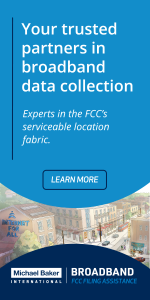
WASHINGTON, January 26, 2023 – The Federal Communications Commission adopted a measure Thursday to eliminate the use of a database that determined the differences in telecommunications service rates in urban and rural areas that was used to provide funding to health care facilities for connectivity.
The idea behind the database, which was adopted by the commission in 2019, was to figure out the cost difference between similar broadband services in urban and rural areas in a given state so the commission’s Telecom Program can subsidize the difference to ensure connectivity in those areas, especially as the need for telehealth technology grows.
But the commission has had to temporarily provide waivers to the rules due to inconsistencies with how the database calculated cost differences. The database included rural tiers that the commission said were “too broad and did not accurately represent the cost of serving dissimilar communities.”

FCC Chairwoman Jessica Rosenworcel gave an example at Thursday’s open meeting of the database calculating certain rural services being cheaper than in urban areas, when the denser latter areas are generally less expensive.
As such, the commission Thursday decided to revert the methods used to determine Telecom Program support to before the 2019 database order until it can determine a more sustainable method. The database rescission also applies to urban cost determinations.
“Because the Rates Database was deficient in its ability to set adequate rates, we find that restoration of the previous rural rate determination rules, which health care providers have continued to use to determine rural rates in recent funding years under the applicable Rates Database waivers, is the best available option pending further examination in the Second Further Notice, to ensure that healthcare providers have adequate, predictable support,” the commission said in the decision.
Healthcare providers are now permitted to reuse one of three rural rates calculations before the 2019 order: averaging the rates that the carrier charges to other non-health care provider commercial customers for the same or similar services in rural areas; average rates of another service provider for similar services over the same distance in the health care provider’s area; or a cost-based rate approved by the commission.

These calculations are effective for the funding year 2024, the commission said. “Reinstating these rules promotes administrative efficiency and protects the Fund while we consider long-term solutions,” the commission said.
The new rules are in response to petitions from a number of organizations, including Alaska Communications; the North Carolina Telehealth Network Association and Southern Ohio Health Care Network; trade association USTelecom; and the Schools, Health and Libraries Broadband Coalition.
“The FCC listened to many of our suggestions, and we are especially pleased that the Commission extended the use of existing rates for an additional year to provide applicants more certainty,” John Windhausen Jr., executive director of the SHLB Coalition, said in a statement.
Comment on automating rate calculation
The commission is launching a comment period to develop an automated process to calculate those rural rates by having the website of the Universal Service Administrative Company – which manages programs of the FCC – “auto-generate the rural rate after the health care and/or service provider selects sites that are in the same rural area” as the health care provider.
The commission is asking questions including whether this new system would alleviate administrative burdens, whether there are disadvantages to automating the rate, and whether there should be a challenge process outside of the normal appeals process.
The Telecom Program is part of the FCC’s Rural Health Care program that is intended to reduce the cost of telehealth broadband and telecom services to eligible healthcare providers.
Support for satellite services
The commission is also proposing that a cap on Telecom Program funding for satellite services be reinstated. In the 2019 order, a spending cap on satellite services was lifted because the commission determined that costs for satellite services were decreasing as there were on-the-ground services to be determined by the database.
But the FCC said costs for satellite services to health care service providers has progressively increased from 2020 to last year.
“This steady growth in demand for satellite services appears to demonstrate the need to reinstitute the satellite funding cap,” the commission said. “Without the constraints on support for satellite services imposed by the Rates Database, it appears that commitments for satellite services could increase to an unsustainable level.”
Soon-to-be health care providers funding eligibility
The FCC also responded to a SHLB request that future health care provider be eligible for Rural Health Care subsidies even though they aren’t established yet.
The commission is asking for comment on a proposal to amend the RHC program to conditionally approve “entities that are not yet but will become eligible health care providers in the near future to begin receiving” such program funding “shortly after they become eligible.”
Comments on the proposals are due 30 days after it is put in the Federal Register.
Originally posted on February 22, 2023 @ 5:25 am


